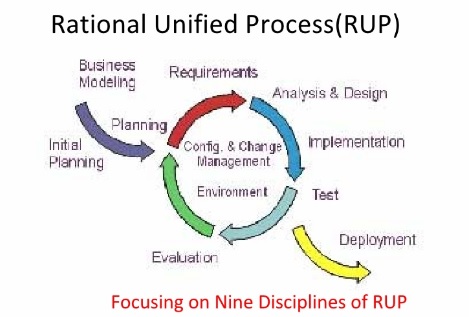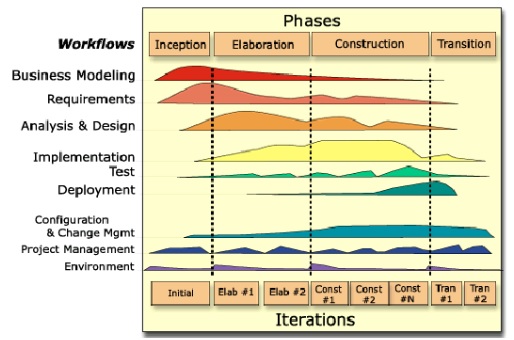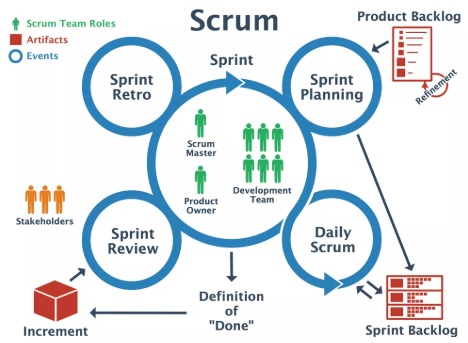Analysis Of Rational Unified Process And Scrum
ANALYSIS OF RATIONAL UNIFIED PROCESS AND SCRUM
Introduction
This paper has been aimed in making an analysis of two methodologies of system development which are Rational Unified Process (RUP) and Scrum. A comparison has been made in this paper regarding the above mentioned two methodologies depending on various aspect of the two methodologiesthat have been discussed in this paper, which includes advantages, disadvantages and factors that are required to be considered while using the methodologies. Guidelines have also been provided in this paper regarding the use of the methodologies in different projects of Innovative Solutions.
Overview of Rational Unified Process
One of the fundamental tenacities of Rational Unified Process is providing a model that would help in the implementation of the different approaches in an effective manner for the development. Rational Unified Process was discovered by the Rational Software Corporation by IBM in the year 2003. The intension of the Rational Unified Process is to adapt the project, team as well as the organization. There are some fundamental ideas on which the process has been depending. One of such idea is building blocks which defines the whole procedure of the development that will take place such as how, when and what development will be taking place in a particular project with the application of Rational Unified Process(Vijayasarathy& Butler, 2016).

There are several factors that are required to be considered by the team members of a project while choosing the application of Rational Unified Process for the development of the project. Some of the factors that are required to be considered are:
- Level of complexity of the project
- Size of the operating system that will be used in the project
- Area in which the particular software will be operating
- The manner in which the project has been organized
- Experiences as well as skills of the members of the project team

RUP is a business modeling methodology that divides the developmental project into 4 sections, namely:
Inception- This is the first phase of project development where study of proposed solution is included analyzing the tangibility and non-tangibility of the resources that are required to complete the project.
Elaboration- In this phase the project is re-evaluated and use-case model is applied to define architecture. It includes all the software utilization which is possible to perform risk assessment on the obstacles identified during the first phase.
Construction-This phase identified the building of the system starting from smaller components to integrate them in shaping the complete project solution.
Transition-After the project is developed; it is then transit from the end of the developer to the client. Adjustment can be made later on according to the level of satisfaction of the client.
It has been found that the adaption of Rational Unified Process methodology in a particular project is complex. Various new and advanced software is required for its application which is not available in small business enterprises. Therefore, this methodology is required to be used in case of large enterprises which are able to invest a large amount of investment for the purchase of software and technologies (Hui et al., 2015). There are six best practices of Rational Unified Process which are as follows:
- Develop software iteratively
- Manage requirements
- Using component based architecture
- Visual model software
- Verification of the quality of the software
- Controlling the changes to software
Overview of Scrum
Scrum is a methodology of agile project management which is used for the project involving software development. The aim of this methodology is delivering capability of new software within a time interval of 2-3 weeks. Agile Manifesto has been influenced by this methodology. It emphasizes on the teamwork of the project management. It has been found that the framework of Scrum is required to design in a simple manner (Abrahamsson et al., 2017). It is considered as an important part of agile software development. It comprises of three parts which are Scrum master, product owner and team. The whole process as well as framework is required to be reviewed and supervised by the Scrum master. A set of principles and values which is outlined in Agile is followed by the team members of the project.

The complexity involved in a project is addressed by the use of Scrum methodology as it helps in making the information of the project transparent. There are three elements of the methodology which are:
Roles
There are four main roles in this methodology which are Scrum Team, Scrum Master, Product Owner and Development Team.
Artifacts
These are the various material result of the work which is Product Backlog, Sprint Backlog, goal of Sprint, increments and definition of done.
Events
It is one of the important elements of Scrum as it provides regularity in the methodology. Some of the events included in the methodology are Sprint, Sprint Planning, Sprint Review and Sprint Retrospective.
There are some factors that are required to be considered by the members of the project team during the application of Scrum methodology which are as follows:
- The structure of the organization
- Process involved in the project
- People who are involved in the project
- Technologies that are being used in the project
- Design of the project
Comparison of Rational Unified Process and Scrum
It has been found in different researches and studies that the application of Rational Unified Process is complex whereas with the application of Scrum, the complexity that is involved in a particular project can be addressed. The Rational Unified Process methodology can be used in the organizations which uses various new and advanced technologies. However, the application of Scrum does not require advanced technologies. Due to this reason, the Rational Unified Process methodology can be applied in case of large enterprises whereas Scrum can be applied in large as well as small enterprises. The main focus of Scrum is on the people and their potential as well as skills. With the help of Scrum, the people who are involved in a particular project are able to discover and identify their capabilities which lead to the growth and success of the organization.
With the help of the application of Scrum, the level of productivity of the product along with its quality can be improved as well as increased. The level of satisfaction of the different stakeholders of an organization can be improved with the help of Scrum. However, it has been found that there are times when the application of Scrum in an organization leads to scope creep due to the absence of a particular end date of the particular project. For the adoption of Scrum, large team is required which is not possible for a small enterprise as they have some employees within the organization (Matharu et al., 2015). It has been found that the main focus of Rational Unified Process is on the need of the accurate documentation for the project development. Various potential integration is diffused by the employees of an organization with the help of Rational Unified Process. With the application of Rational Unified Process, the various changes that are taking in the environment of an organization can be adapted by its employees in a proper as well as effective manner (TP026B, 2017). However, one of the biggest drawback of Rational Unified Process is that its success depends on the proficient as well as expert members of the project team which requires hiring of some expertise within the organization. This is not always possible for a small enterprise as it involves large amount.
Guidelines
Guideline for Rational Unified Process
There are four life cycle phases involved in the application of Rational Unified Process which are as follows:
Inception phase:
At this phase, the employees are required to determine the idea as well as structure of the project. The team members are required to make a discussion regarding the project so that its worth can be identified. While making the discussion, various factors are required to be considered by the members of the project. These are purpose of the project, resources that will be required in the project and cost involved in the project.
Elaboration phase:
In this phase, various architecture requirements of the system are required to be analyzed by the employees. It is one of the most Citrucel phase. Therefore, the employees are required to maintain a high level of care at this phase.
Construction phase:
At this phase, all the applications proposed in the above stages are implemented by the employees of the organization. Integrations are done with the other services as well as software at this phase (Bik, 2016).
Transition phase:
At this phase, the project is completed by the employees and delivered to the clients of the organization. This is required to be done in a proper as well as effective manner.
Guideline for Scrum
For the application of Scrum methodology, various tools of Scrum are required to be used by the employees. Some of the tools are white board, spreadsheet and sticky notes. The various challenges that are involved in a project is required to be addressed by the employees. The members of the project team are required to develop plan as well as report on the software. This will help them in tracking the growth and progress of the software. Various resources that are required for the completion of the project are arranged by the employees. After that a plan is required to be developed for the application of Scrum in the project which is then implemented. The implementation of the plan is required to be supervised by the Scrum master for ensuring its success.
Based on the above work, the following are the steps for designing the solution and taking the informed decision for choosing between Rational Unified Process and Scrum:
- nature of the project: if the project involves complexity then Rational Unified Process should be chosen as it will help in visualizing the output of the project. If the project is comparatively easy and simple, Scrum should be adopted as it will help in the completion of the project within the specified time period.
- Determination of the project size: if the size of the project is considered to be big, Rational Unified Process should be adopted. A project which is small in size cam adopt Scrum.
- critical parameters of project: in a project which is time critical, Rational Unified Process should be adopted. In a project that requires quality, Scrum should be adopted. With the application of Scrum, the quality of the project can be improved and enhanced according to the requirement of the clients.
- Role of the client: when there is active participation of the clients at the initial phase, Rational Unified Process should be preferred. If in a project, software development process is required, Scrum should be preferred.
Conclusion
In this paper, a project has been developed regarding Rational Unified Process and Scrum for the employees of Innovative Solutions. Various aspects of Rational Unified Process and Scrum have been analyzed and discussed in this project in a detailed manner for proving an in-depth knowledge regarding the above mentioned two methodologies.
References
Abrahamsson, P., Salo, O., Ronkainen, J., &Warsta, J. (2017). Agile software development methods: Review and analysis. arXiv preprint arXiv:1709.08439.
Balijepally, V., &Nerur, S. (2015). Understanding the Structure of Agile Software Development Using Text Analytics: A Preliminary Analysis.
Bik, N. (2016). Rational Unified Process.
Hui, Y., Yan, Y., Quanyu, W., &Zhiwen, C. (2015, June). Compare Essential Unified Process (EssUP) with Rational Unified Process (RUP). In Industrial Electronics and Applications (ICIEA), 2015 IEEE 10th Conference on (pp. 472-476). IEEE.
Matharu, G. S., Mishra, A., Singh, H., &Upadhyay, P. (2015). Empirical study of agile software development methodologies: A comparative analysis. ACM SIGSOFT Software Engineering Notes, 40(1), 1-6.
TP026B, R. (2017). Rational Unified Process. URL: https://www. ibm. com/developerworks/rational/library/content/03July/10 00/1251/1251_bestpractices_TP026B. pdf Cited October, 18.
Turk, D., France, R., &Rumpe, B. (2014). Limitations of agile software processes. arXiv preprint arXiv:1409.6600.
Vijayasarathy, L. R., & Butler, C. W. (2016). Choice of software development methodologies: Do organizational, project, and team characteristics matter?. IEEE software, 33(5), 86-94.
Buy Analysis Of Rational Unified Process And Scrum Assignment Answers Online
Talk to our expert to get the help with Analysis Of Rational Unified Process And Scrum Assignment to complete your assessment on time and boost your grades now
The main aim/motive of the management assignment help services is to get connect with a greater number of students, and effectively help, and support them in getting completing their assignments the students also get find this a wonderful opportunity where they could effectively learn more about their topics, as the experts also have the best team members with them in which all the members effectively support each other to get complete their diploma assignments. They complete the assessments of the students in an appropriate manner and deliver them back to the students before the due date of the assignment so that the students could timely submit this, and can score higher marks. The experts of the assignment help services at urgenthomework.com are so much skilled, capable, talented, and experienced in their field of programming homework help writing assignments, so, for this, they can effectively write the best economics assignment help services.
Get Online Support for Analysis Of Rational Unified Process And Scrum Assignment Assignment Help Online
Resources
- 24 x 7 Availability.
- Trained and Certified Experts.
- Deadline Guaranteed.
- Plagiarism Free.
- Privacy Guaranteed.
- Free download.
- Online help for all project.
- Homework Help Services
Testimonials
Urgenthomework helped me with finance homework problems and taught math portion of my course as well. Initially, I used a tutor that taught me math course I felt that as if I was not getting the help I needed. With the help of Urgenthomework, I got precisely where I was weak: Sheryl. Read More

